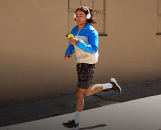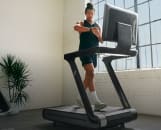
Elena Popova via Getty Images
What to Do After a Half Marathon for a Smooth Recovery
These expert-approved tips will help you get back on your feet fast.
By Sarah Klein•
What to Do Immediately After Your Half Marathon
Recovery Tips for the Day of Your Half Marathon
Next-Day Half-Marathon Recovery
What to Do In the Week After Your Half Marathon
The Takeaway
Finishing a half marathon is no small accomplishment. Sure, the 13.1-mile distance isn’t quite as intense as a full marathon at 26.2 miles, but after months of training and race day itself, it’s time to celebrate and recover.
In general, half marathon recovery will look similar to recovery practices for longer distances like the marathon. “It’s not all that different, except that in running a marathon, you’re obviously expending more energy and putting additional stress on your body,” says sports dietitian Claire Shorenstein. For example, Peloton instructor Camila Ramón says her half marathon recovery period is typically less than half of what she needs to recover from a full marathon. Still, your body needs some TLC after going the distance—and we have expert-approved recovery tips to help.
Keep reading for the best movement, nutrition, and mobility steps to take after a race to help speed up recovery. Here’s your complete post–half marathon recovery guide.
What to Do Immediately After Your Half Marathon
It’s easy to think of recovery as something that happens in the evening or days after your race, but your recovery starts the minute you cross the finish line, says Catherine Wysin, a physical therapist at the Hospital for Special Surgery in New York City. Here’s what you should do right after your race to kickstart the process.
Keep Moving
While it’s tempting to find the nearest couch and plop yourself on it, the most important thing to do immediately after you finish your half is to avoid the temptation to just sit down, Wysin says.
Yes, you’re tired, and you’ve certainly earned a rest, but try to keep walking for a short period of time. Walking helps keep your blood flowing, which delivers nutrients to your muscles to help them heal and repair. “The minute you sit, you’re going to stiffen up, and you’re actually going to be a little bit more uncomfortable,” Wysin says. At the very least, walk until you meet up with the friends and family cheering you on, get back to your car, or arrive at your post-race brunch spot, she says.
Roll or Stretch (If You’re Up for It)
If you’re in a lot of pain, don’t rush to stretch or foam roll, Wysin says. But if you feel a normal amount of tightness and soreness, it’s safe to do either immediately after finishing a race. “Focus on the main muscle groups used during your race: quads, hamstrings, calves, and glutes,” she says. “Roll gently, starting with light pressure, and adjust accordingly. The key is to keep things gentle and comfortable and to not push yourself too hard.”
Try a Post-Run Stretch on the Peloton App
See all classesRehydrate and Refuel
Otherwise, the more important thing to do right after your race is to immediately hydrate and refuel, Camila says. First and foremost, focus on replacing the fluids and electrolytes you lost from sweat, Shorenstein adds. She typically recommends consuming 16 to 24 ounces of fluids after a half marathon. You can opt for an electrolyte drink or plain water and some food that contains salt and other minerals lost in sweat, such as potassium and magnesium. Her picks? Smoothies, protein shakes, chocolate milk, broth-based soups, and water-rich fruits like watermelon.
You also need to replenish carbohydrates after a half because you just burned through all the available energy your body had stored. If you’re not hungry right after finishing, Shorenstein suggests at least having a protein shake or small snack of easy-to-digest, simple carbs (such as a bagel or rice cakes). These will replenish your body’s energy stores more quickly than complex, harder-to-digest carbs (like oatmeal or beans). If you only manage to eat something small right after your half marathon, try to have a full meal 60 to 90 minutes later, she adds.
If you can stomach it, eating a full meal within the hour after your race is an even better idea, Shorenstein says. This meal should aim to hit specific nutrition targets to speed recovery. Ideally, try to get 50 to 90 grams of carbs and 20 to 40 grams of protein, Shorenstein says.
These benchmarks can fluctuate a bit depending on factors like your weight and age, how intensely you raced your half, and your long-term goals, she says, but they’re a good starting point. You can personalize this approach by doing some quick calculations based on your body weight, she adds. Try to get 1 gram of carbs per kilogram of your body weight and 0.5 grams of protein per kilogram of your body weight. (Pro tip: Divide your weight in pounds by 2.2 to calculate your weight in kilograms.)
Include some fats from sources like avocado, olive oil, nuts, seeds, and fatty fish to help absorb other nutrients in your food and reduce inflammation in this meal, too, Shorenstein adds. And don’t forget about fruits and veggies. A range of colorful produce helps you get the micronutrients and antioxidants you need for recovery, she says.
Just be sure to stick to easy-to-digest foods so you can reload your energy stores quickly and efficiently, Shorenstein says. That’s especially true if you find yourself dealing with runner’s stomach—a relatively common constellation of gastrointestinal issues that tend to plague distance runners on race day and otherwise. Some smart post-race meal ideas include:
Smoothie with protein powder
Yogurt with granola and fruit
Chocolate milk and fruit
Breakfast sandwich with egg, avocado, and fruit
Grain bowl or burrito bowl with protein
Deli sandwich with fruit
Related Articles
Recovery Tips for the Day of Your Half Marathon
Once you’ve returned home, the next stage of your post–half marathon recovery can begin.
Give Your Muscles Some TLC
If you’re into cold plunging, now is the time for a cold shower or an ice bath, Wysin says. The chilly water might help stem some inflammation, soreness, and fatigue. In fact, cold water immersion was more effective at reducing measures of fatigue in half marathoners than active recovery and rest, according to one small PLoS One study.
Whether or not you take a cold plunge, the rest of the day is a good opportunity for some foam rolling and gentle stretching to further ease potential soreness, Wysin says. You can take guided classes for both types of recovery sessions in the Peloton App. If you have access to them, compression boots are also a great option, Camila says.
Eat Regularly
To continue refueling, Shorenstein recommends eating consistently—i.e., every three to four hours—throughout the rest of the day to support the recovery process. “All too often, I see athletes have a smoothie and/or a large post-race meal, and then neglect nutrition and hydration for a large chunk of time,” she says.
That’s understandable: You might be distracted by celebrating your half-marathon success or taking a well-deserved nap, for example. But aim for a balanced lunch and dinner with a snack in between. At this point, you still want your meals to be rich in carbs and protein with some filling fat, Shorenstein says. By several hours after your half, you can choose more of the slower-digesting, fiber-rich carbs like whole grains, beans, and legumes, too, she adds.

Peloton App
Access thousands of classes with no equipment needed.
Keep Hydrating
Make sure you’re drinking plenty of fluids throughout the rest of the day, too. If you’re looking for an easy way to check your hydration status, take a peek in the toilet bowl: You’re looking for pale yellow urine.
If you feel up for it, you can get a little more scientific with hydration: Organizations like the National Academy of Sports Medicine recommend sipping 16 to 24 ounces of water or a sports drink for every pound of body weight you lost during your race. Some research even suggests you should aim to drink 125 to 150 percent of the fluids you lost within six hours after a workout. Of course, that requires weighing yourself before and after your race, which isn’t always practical. If your half marathon was at altitude or it was really hot or humid out while you were running, you’ll probably want to get even more, Shorenstein says.
While some people like to celebrate post-race with an alcoholic drink, it’s best to limit booze. “It can reduce your body's ability to restock glycogen stores and build new muscle tissue,” Shorenstein says. Instead, consider a non-alcoholic option like one of her favorite post-run mocktails: “Mix pomegranate or tart cherry juice with lemon or lime seltzer and some coconut water to get some carbs and antioxidants in while also rehydrating,” she says.
Rest as Needed
In between meals, snacks, and refilling your water bottle, it’s time to rest. “Take time off your feet, and don’t judge yourself for feeling tired,” Camila says.
For some people, spending the remainder of the day chilling out is the perfect plan. Other runners might take a couple of hours to rest and then go about their day as normal. It depends on your running history, Wysin says. First-time half marathoners may feel more fatigued than more experienced half marathoners or marathoners. (In fact, some people may even be doing a half marathon as part of their full marathon training plan.) If you were dealing with an injury during your race or training or you’re feeling particularly under the weather, you may need more rest today, too.
Prioritize Sleep
No matter how you spend the remainder of the day, aim for a good night’s sleep, Wysin says. “Your body has really been through the ringer after running a half marathon. You’ve expended a lot of energy,” she says. “Your body needs its time to rest and repair, and that happens best when you’re sleeping.” Camila seconds that and recommends sleeping as much as possible.
To maximize your sleep tonight and for the next several days, try to stick to a consistent bedtime and wake-up time; keep your bedroom cool, dark, and quiet; practice some calming activities before bed, such as journaling or meditating; and limit screen time in the hour before bed.
Next-Day Half-Marathon Recovery
As long as you’re not nursing an injury, you can probably get some light activity the day after your half. Wysin suggests walking, easy cycling, gentle swimming, or any other low-impact, low-intensity activity to improve circulation and reduce inflammation.
This is a great day for foam rolling or even treating yourself to a massage, Wysin says, as long as you’re not feeling overly sore. “You’re probably going to be fairly sore the next day and probably the second day after your half marathon,” she says. “I tend to like foam rolling better than getting a massage at this point because I can gauge how much pressure to use.” If you’re new to foam rolling, try a guided, instructor-led session, like a 10-minute foam rolling class on the Peloton App.
You can start to eat normally again today, or at least normally for how you would eat on a training day, Shorenstein says. “The body is still in recovery mode. Continue to give it the macro- and micronutrients that it requires,” she says.
Prioritize plenty of sleep tonight, too, Wysin says, sticking to the tips above.
What to Do In the Week After Your Half Marathon
Throughout the rest of the week, you probably have one big question on your mind: When can I get back to running? There’s no hard-and-fast rule. “It varies with every athlete,” Camila says. “Some people feel like they can get back into things sooner than others. The main thing is to listen to your body and to ease back in.”
If you’re really still sore, fatigued, tired, or having discomfort with daily activities, you're probably not ready to start running, Wysin says. If that’s you, stick to low-intensity, low-impact exercise this week, accompanied by more stretching, foam rolling, and rest.
“When you’re ready, start with shorter distances at a recovery or easy pace and slowly begin to increase again,” Camila says.
More experienced runners or those training for longer distances or who have another race coming up may not need to take this whole week off running. But regardless of your running experience or training schedule, Wysin suggests starting with some light, easy miles for your first run after a hard half marathon to assess how you feel before pushing yourself again.
It isn’t always easy to hold yourself back like this, but returning to running too quickly or intensely can lead to overuse injuries that may sideline your progress, Wysin warns. “I think the goal should always be to get to the next start line healthy. If you don’t respect the recovery process and give your body time to heal, there's a higher possibility you’re going to set yourself up for injury.”
Instead of running, consider cross-training. “You can still keep a solid baseline of cardio fitness that will aid in running while you’re taking a break,” Camila says. Try cycling, rowing, swimming, or another low-impact cardio activity.
In terms of nutrition, you don’t have to be too strict the rest of this week as long as you’re listening to your body and giving it what it needs, Shorenstein says. Most importantly, continue to consistently eat regular meals and snacks so you’re giving your body enough recovery fuel, she says.
And don’t forget about your sleep just because race day is getting further and further behind you. Aim for plenty of restorative shuteye throughout this entire week, Wysin says—ideally seven to eight hours per night, or more.
The Takeaway
Half-marathon recovery is multi-faceted. In the days after your race, you’ll want to take some time off running, get quality sleep, prioritize balanced meals, drink plenty of fluids, and experiment with different forms of active recovery like stretching and foam rolling.
It’s important to find low-impact ways to stay active, like gentle swimming or cycling, in the days after running a half marathon. And eating regular meals and snacks with plenty of carbs, protein, healthy fats, and micronutrients can help your body recover and support your efforts to get back to running safely and efficiently. Expect to take several days and up to a week or two off running, depending on your fitness level, goals, and training plan.
When in doubt, listen to your body, and don’t push yourself back into hard workouts too soon. As Camila says: “You just did an incredible athletic feat—you deserve rest!”
This content is for informational and educational purposes only and does not constitute individualized advice. It is not intended to replace professional medical evaluation, diagnosis, or treatment. Seek the advice of your physician for questions you may have regarding your health or a medical condition. If you are having a medical emergency, call your physician or 911 immediately.
Take your runs to the next level
Lace up and enter your email to get articles, instructor tips, and updates from Peloton sent to your inbox.
By providing your email address, you agree to receive marketing communications from Peloton.
For more about how we use your information, see our Privacy Policy.















